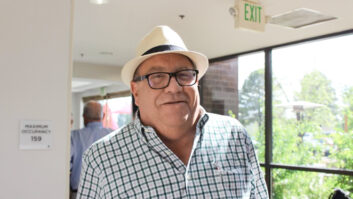Among the many themes of the recent NAB Show was the future of radio in the new media landscape. NAB President/CEO Gordon Smith touched on that in a keynote address, excerpted here.
Where do you want your businesses to be in 5 years? In 10 years? In 20 years?
A recent Wall Street Journal article had the headline “Don’t Look Now: A Car That Tweets.” The article said that Ford already allows drivers to send and receive Tweets, stream Internet music and access podcasts. And soon, drivers of other vehicles will be able to check Facebook and buy movie tickets.
How does radio fit into this scenario — what do we see as radio’s future — is it streaming or over the air, or both?
Some believe streaming is the future. Others believe it does not grow the bottom line — that stations should focus on bringing in more traditional revenues.Are you feeling pressure to jump into streaming?Perhaps you are sensitive to criticism that if radio doesn’t get into streaming, you will be left behind or seen as resistant to change.

© NAB Show
Only you know the right answer for your business, but whatever path radio decides to take, NAB will be there to advocate on your behalf to help ensure a robust future for many decades to come. …
I have always heard broadcasting described as ubiquitous. But ubiquity yesterday meant a radio being on the dashboard, in the kitchen and on the nightstand. Ubiquity meant a television in every living room — these days, almost every room in the house. But ubiquity tomorrow must mean broadcasting’s availability to all people at all times in all places and on all devices. The current broadcasting model can be undone by technology, or government, or some unintended consequence from either.
It says in the book of Proverbs, “Without a vision, the people perish.” I genuinely believe if we have clear-headed thinking and proper vision, our business will continue to prosper. And I have no doubt about what that vision is: to educate, inform and entertain viewers and listeners through our one to many transmission — again, to all people, at any time and on every device.
The wireless industry wants to replicate what we do. In fact, they are developing their own mobile-TV network; but they say they need more spectrum. And they could get what they want, pending approval from the government. …
Here’s the problem: Even with all the spectrum in the universe, the wireless industry’s “one-to-one” architecture could never match our ability to broadcast voice and video to the masses.Broadband can never replicate the lifeline role of the local broadcaster. Broadcasters are always on, always there when you need them. Especially in an emergency. …
[E]ven today, broadcast radio and TV are where the ears and eyeballs are. After all, more than 241 million people listen to free radio every week.
Even in an era of Pandora and Spotify, local radio is by far the number one source for new music.And this is just using our existing business model.
Radio has new opportunities including on mobile phones.This is a standard feature on cell phones in Europe and Asia.
Many phones in the U.S. already have this capability, but the carriers don’t make that known and may refuse to activate the chip. Why?
Some say because they have a vested interest in charging consumers with fees for data streaming.But given the certain failure of mobile phones in a lifeline situation, we’re hopeful that over time, carriers will come to understand and appreciate the importance of having an activated radio tuner in these devices, and to off load their ever congested airwaves. …
But despite the tired claims of our misguided critics, broadcasting is a robust business. Both radio and TV have cycled out of the worst advertising recession in history. Yes, there are challenges, but broadcast revenues remain strong and growing. And the future is bright.
We’re evolving onto new platforms. And it’s not just on mobile phones. We also need to be on tablets, laptops and game consoles and on mobile devices not yet developed. We expect our newly-launched NAB Labs will be at the forefront of this initiative to push the limits of broadcasting.
We will provide a platform for innovation and for testing new technology.Our adversaries would like people to believe that the best days of broadcasting are over. We will prove them wrong.
Read the full transcript at radioworld.com/May-09-2012.
Comment on this or any story at [email protected].












